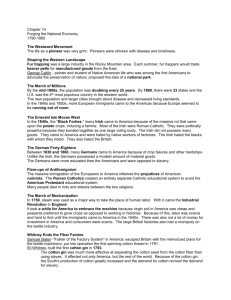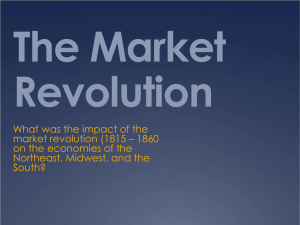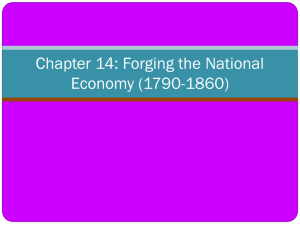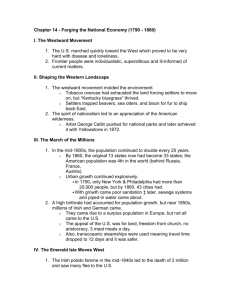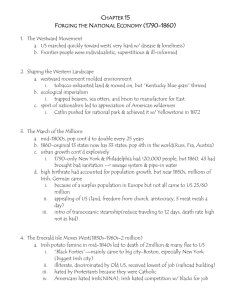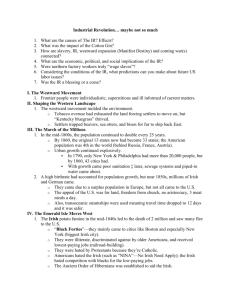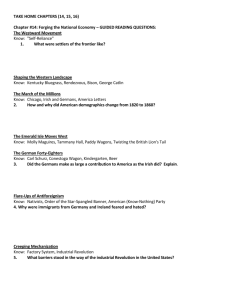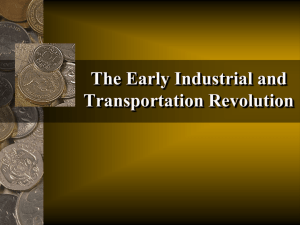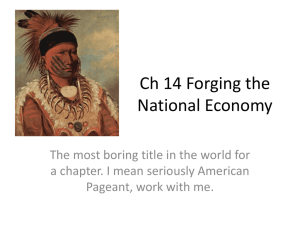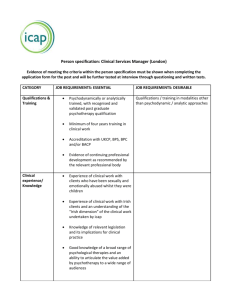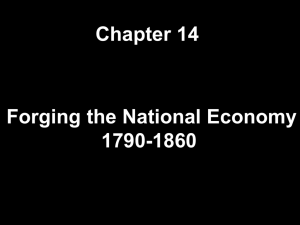Document
advertisement
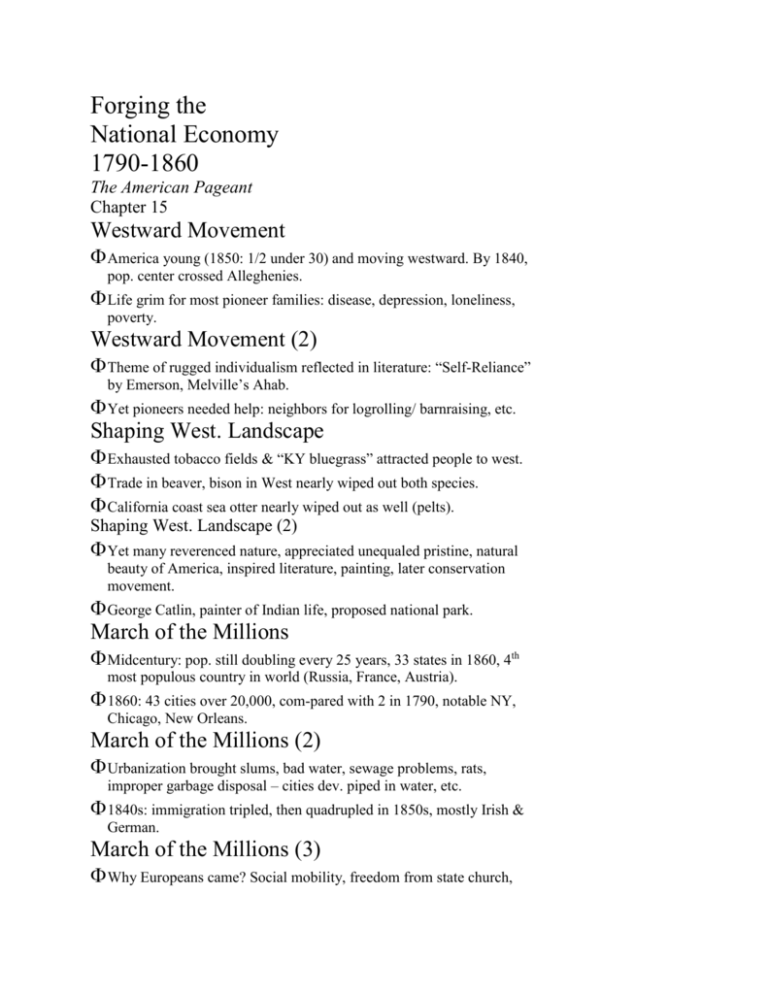
Forging the National Economy 1790-1860 The American Pageant Chapter 15 Westward Movement America young (1850: 1/2 under 30) and moving westward. By 1840, pop. center crossed Alleghenies. Life grim for most pioneer families: disease, depression, loneliness, poverty. Westward Movement (2) Theme of rugged individualism reflected in literature: “Self-Reliance” by Emerson, Melville’s Ahab. Yet pioneers needed help: neighbors for logrolling/ barnraising, etc. Shaping West. Landscape Exhausted tobacco fields & “KY bluegrass” attracted people to west. Trade in beaver, bison in West nearly wiped out both species. California coast sea otter nearly wiped out as well (pelts). Shaping West. Landscape (2) Yet many reverenced nature, appreciated unequaled pristine, natural beauty of America, inspired literature, painting, later conservation movement. George Catlin, painter of Indian life, proposed national park. March of the Millions Midcentury: pop. still doubling every 25 years, 33 states in 1860, 4th most populous country in world (Russia, France, Austria). 1860: 43 cities over 20,000, com-pared with 2 in 1790, notable NY, Chicago, New Orleans. March of the Millions (2) Urbanization brought slums, bad water, sewage problems, rats, improper garbage disposal – cities dev. piped in water, etc. 1840s: immigration tripled, then quadrupled in 1850s, mostly Irish & German. March of the Millions (3) Why Europeans came? Social mobility, freedom from state church, land. Introduction of steamships allowed crossing Atlantic in 10 or 12 days. Emerald Isle Moves West 1840s: 2 million Irish died in potato famine, many came to America. Irish too poor to move west, settled in Boston & NY, crammed into slums, shunned b/c they were Catholics. Emerald Isle Moves West (2) Irish took menial jobs (kitchen maids, RR workers), hated b/c were willing to work for less, led to “No Irish Need Apply.” Irish resented blacks b/c com-petition, resulted in race riots with Irish/black dockworkers. Emerald Isle Moves West (3) Ancient Order of Hibernians: benevolent society to help Irish, spawned “Molly Maguires” (miners union). Gradually improved lot, became active politically – NY’s Tam-many Hall, Irish pol. machine. German 48ers Most Germans came due to crop failures, but some political refugees from collapse of democratic revolutions in 1848. Germans better off than Irish, came west, many to Wisconsin. German 48ers (2) German contributions: Kentucky rifle, Xmas tree, Kindergarten; abolitionists. Some Americans suspicious b/c they tried to preserve language/ culture, lived in separate communities, drank beer. Antiforeign Flare-Ups American “nativists” feared 1840s & 50s invasion of immigrants: took jobs, grew Roman Catholicism. Catholics built their own schools, were #1 denomination by 1850. Antiforeign Flare-Ups (2) 1849: Nativists form Order of the Star-Spangled Banner, developed into “Know-Nothing” party. Wanted immigration restrictions. Nativists occasionally violent, burned Boston convent (1834). Antiforeign Flare-Ups (3) 1844: Phil. Irish fought back, 13 killed in several days of fighting. Why not more clashes in such diverse society? Robust American economy could take them in. March of Mechanization 1750: Factory system invent. in Britain, led to Industrial Rev. America slow to embrace, why? Cheap land, scarce labor, little capital, few consumers, superiority of British factories, secrecy of machine designs. Whitney ends Fiber Famine Samuel Slater – “Father of Factory System”: memorized machine plans, escaped to US. 1791: 1st US machinery in place for spinning cotton thread, but where’s cotton? Whitney ends Fiber Famine (2) 1793: Eli Whitney invents cotton gin, 50x more effective than handpicking. Suddenly, raising of cotton highly profitable, South tied to King Cotton, kept demand for slaves. Whitney ends Fiber Famine (3) New England factories flourish-ed with southern cotton. Why NE favored for manufac-turing? Soil discouraged farm-ing, dense pop. gave labor & markets, shipping brought cap-ital, rivers powered machines. Manufacturing Marvels Eli Whitney also invents principle of interchangeable parts, used in muskets for army. 1850: principle widely adopted, led to mass production, & gave North large industrial plants, military superiority over South. Manufacturing Marvels (2) 1846: Sewing machine inv. by Howe, perfected by Singer, gave boost to northern industry. Became foundation for ready-made clothing industry, led many women into factories. 1800–306 patents: 1860–28,000 Manufacturing Marvels (3) Principle of limited liability led to corporations, more capital. 1844: Samuel F. B. Morse demonstrates telegraph between Washington & Baltimore. Workers & Wage Slaves Prior manufacturing done in home or small shop. With industrial revolution, large impersonal factories surrounded by slums full of “wage slaves” developed. Workers & Wage Slaves (2) Long hours, low wages, unsanitary conditions, lack of heat, etc. Labor unions illegal. 1820: 1/2 of industrial workers were children under 10. Workers & Wage Slaves (3) 1820s & 30s: right to vote for laborers, loyalty to Dem. party led to improved conditions. Fought for 10-hour day, higher wages, better conditions. 30s & 40s: Dozens of strikes for higher wages or 10-hour day. Workers & Wage Slaves (4) 1830: 300,000 in trade unions, but 1837 depression hurt union membership. 1842: Commonwealth v. Hunt – Sup. Ct. ruled unions not illegal conspiracies as long as peaceful. Women & the Economy Some women in factories working 6 days, all day, but most working women in nurs-ing, domestic service, teaching. 1850: 10% of white women working for pay outside home. Women & the Economy (2) Vast majority of working women were single. Left paying jobs upon marriage. “Cult of domesticity” develops: cultural idea that glorifies homemaker, empowers married women. Women & the Economy (3) Increased power & independ-ence of women in home led to decline in family size, more child-centered parenting, more affectionate families. Parenting goal: people who could make own decisions. Revolution in the Fields Strong agricultural production in West, esp. corn (hog market). Western produce floated down Ohio/Miss. rivers to South. Wanted more land to farm, but tough soil broke wooden plows. Revolution in the Fields (2) 1837: John Deere produced steel plow in Illinois. 1830s: McCormick invents mower-reaper, subsistence farming became cash-crop. Needed more markets for goods, but no way east. Highways & Steamboats 1790s: roads bad, transporta-tion highly unreliable. 1790s: 1st toll road: Lancaster turnpike, highly profitable. Turnpikes brought canvas-covered Conestoga wagons west. Highways & Steamboats (2) Western road building blocked by states’ righters, & and eastern states afraid of losing population. But fed gov’t did build Cumber-land Road, 1811-1852, MD to IL, 591 miles. Highways & Steamboats (3) 1807: Robert Fulton launches Clermont on Hudson River, 1st steamboat. Upstream travel now possible, rivers 2-way, more trade. 1820: 60 steamboats on Miss., 1860: about 1,000. Clinton’s Big Ditch in NY 1817-1825: NY, under leadership of Gov. Clinton, builds Erie Canal, 363 miles, connects Hudson w/ Great Lakes. Shipping ton of grain from Buf-falo to NYC was $100, now $5. Clinton’s Big Ditch in NY (2) Farming in OH, MI, IN, IL now highly profitable, attracted Europeans. NY food prices cut in half, New England farmers cannot com-pete, more go toward factories. National economy developing. Pioneer RR Promoters RR proved most sig. develop-ment toward national economy. Faster, cheaper, more reliable than canals, defied terrain & weather. 1st RR in 1828; by 1860, 33,000 miles of track, most in North. Pioneer RR Promoters (2) Obstacles: opposition from canal backers, danger of fire, poor brakes, difference in track gauge meant changing trains. Obstacles eventually overcome: Pullman “sleeping palace” produced in 1859. Trans. Web Binds Union Canals & RR bound West to East (more than South w/ Miss), NYC became dominant port. Eve of Civil War, continental economy in place. South - Cotton; West grain/livestock; East - machines/textiles. Trans. Web Binds Union (2) South underestimated ties of Miss. Valley with East, thought Miss. river would force northwest to be loyal to South. Economy had social effects: many left home to work, bought fabrics, etc. made elsewhere. Wealth & Poverty Some becoming very wealthy, e.g. John Jacob Astor. Mass of unskilled workers in cities showed inequality. But their wages rose 1%/year from 1820-60 – increased standard of living. Cables, Clippers, Riders 1858: Cyrus Field stretched telegraph cable across Atlantic, went dead, replace in 1866. 1840s - 50s: Clipper ships introduced. Faster than steamers, but could not hold as much. Cables, Clippers, Riders (2) But British steamers proved more profitable, clipper ships obsolete on eve of Civil War. 1858: Stagecoaches to Calif. 1860: Pony Express established, lasted only 18 months, replaced by telegraph.
